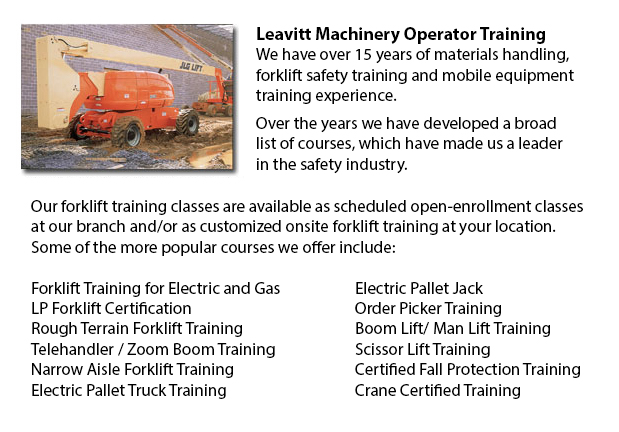
Guelph Boom Lift Certification - The use o elevated work platforms allow for work and maintenance operations to be performed at elevated work heights which were otherwise unreachable. Workers using scissor lifts and boom lifts can be educated in the safe operation of these devices by receiving boom lift certification training.
When work platforms are operated unsafely, they have the possibility for serious injury and even death, regardless of their lift style, site conditions or application. Falls, electrocution, tip-overs and crushed body parts could be the unfortunate result of incorrect operating procedures.
In order to avoid aerial lift accidents, individuals need to be qualified to be able to train workers in operating the specific type of aerial lift they will be using. Controls must be easily accessible in or beside the platform of boom lifts used for carrying workers. Aerial lifts must not be be altered without the express permission of other recognized entity or the manufacturer. If you are renting a lift, ensure that it is properly maintained. Prior to utilizing, safety devices and controls must be inspected to be able to ensure they are functioning correctly.
It is vital to follow safe operating procedures in order to avoid workplace accidents. Driving an aerial lift while the lift is extended should not be done, nonetheless, a few models are designed to be driven when the lift is extended. Always set brakes. Set outriggers, if available. Avoid slopes, but when necessary use wheel chocks on slopes that do not go over the manufacturer's slope limits. Follow weight and load limitations of the manufacturer. When standing on the platform of boom lifts, make use of a safety belt with a two-foot lanyard tied to the basket or boom or a full-body harness. Fall protection is not required for scissor lifts which have guardrails. Do not sit or climb on guardrails.
The boom lift certification course provides instruction in the following fields: safety guidelines in order to prevent a tip-over; training and certification; slopes and surface conditions; inspecting the work area & travel path; stability factors; other tips for maintaining stability; leverage; weight capacity; pre-operational check; testing control functions; safe operating practices; mounting a vehicle; safe driving procedures; power lines and overhead obstacles; making use of lanyards and harness; PPE and fall protection; and prevent falling from platforms.
The trainee who is successful would learn the following: authorization and training procedures; pre-operational inspection procedures; factors affecting the stability of scissor and boom lifts; how to prevent tip-overs; how to utilize PPE, how to use the testing control functions and fall prevention strategies.
-
Guelph Warehouse Forklift Training Classes
Guelph Warehouse Forklift Training Classes - Warehouse training classes exist for the reason of raising awareness regarding common warehouse hazards. Students learn the important safety procedures that are necessary to warehouse safety. An emphasis i... More -
Guelph Forklift Operator Certification
Guelph Forklift Operator Certification - Certification for forklifts are needed to guarantee the safe use of forklifts for those employers in construction, industrial and warehouse settings. The training has to involve a method of education plus some... More -
Guelph Crane Training School
Guelph Crane Training School - The crane training school offers industry-relevant programs. Courses provide trainees with learning results that match current industry demands. Our small class sizes combine hands-on experience and theory. Our qualifie... More -
Guelph Heavy Equipment Training Programs
Guelph Heavy Equipment Training Programs - At whatever given construction site, there are usually various kinds of machines that are ready to be used. These heavy and light equipment need both operators to run them and mechanics to fix them. Apprenti... More -
Guelph Skid Steer Ticket
Guelph Skid Steer Ticket - On a skid-steer loader, the lift arms are at the side of the driver together with pivot points at the back of the driver's shoulders. This makes them different compared to a traditional front loader. Because of the operator... More -
Guelph Zoom Boom Ticket
Guelph Zoom Boom Ticket - Zoom Boom Training focuses on correctly training prospective operators on variable reach forklifts. The training goals include gaining the understanding of the equipments physics and to define the tasks of the operator. This... More -
Guelph Heavy Equipment Training
Guelph Heavy Equipment Training - Commonly, the different types of heavy equipment training are divided into 2 categories of machinery: those that have rubber tires and tracked vehicles. Tracked vehicles consist of items like for instance bulldozers,... More -
Guelph Aerial Lift Safety Training
Guelph Aerial Lift Safety Training - Each year, there are roughly 26 construction deaths due to the use of aerial lifts. Nearly all of the craftsmen killed are laborers, electrical workers, carpenters, painters or ironworkers. Nearly all deaths are c... More

Forklift Certification Guelph
TOLL FREE: 1-888-254-6157
Guelph, Ontario
forkliftcertificationguelph.com
Email Us
About Us


